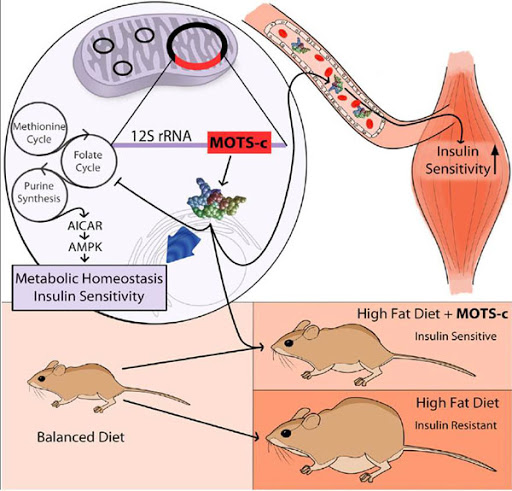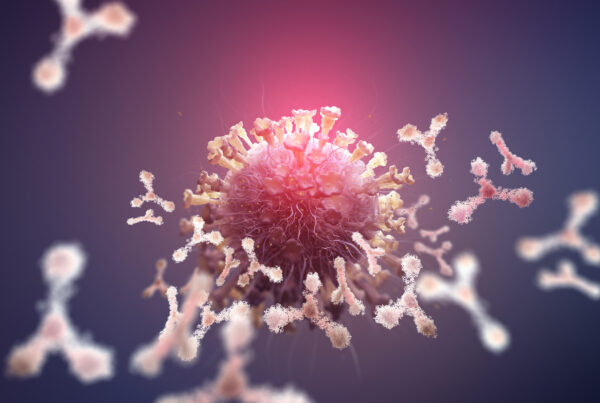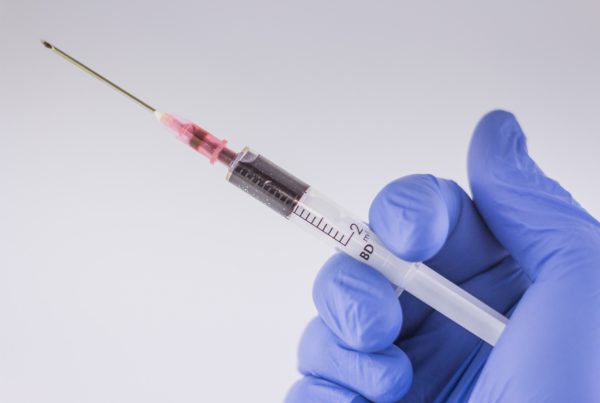MOTS-c is a mitochondrial peptide that has been shown to regulate and improve insulin sensitivity, metabolic homeostasis, and help protect age- and diet-dependent insulin resistance.
It has also been shown to lower or prevent obesity.
MOTS-c, a sixteen amino-acid peptide, allows you to lose more fat and gain more energy, all while helping you become healthier at the mitochondrial DNA level.
Let’s take a deeper dive into this process…
What are Mitochondria and Why Do They Matter?
Mitochondria are structures within a cell that produces energy and are one of the most important key players in understanding the aging process. As we age, the mitochondria begin to dysfunction – partly due to the accumulation of mitochondrial DNA damage – and this dysfunction is the hallmark of aging.
This is what I like to call the combination of YOLO and “living your best life” over time, starting from birth.
To keep it simple, mitochondria are responsible for generating energy in the form of ATP (adenosine triphosphate). This energy drives the processes within living cells.
If this function becomes reduced, slowed, or crippled, then as human beings, we also become reduced, slowed, and crippled.
This is what happens as we age.
But First, Let’s Talk About Metabolic Syndrome…
According to the National Institute of Health, metabolic syndrome is a group of conditions that put you at a higher risk of developing type II diabetes, stroke, and heart disease. These conditions can include high blood pressure, abnormal cholesterol levels, high blood sugar, and excess body fat.
Some people have a higher risk of developing metabolic syndrome than others, and we can prevent many of these cases. The ultra-simple recipe for metabolic syndrome includes:
- Excess body fat (obesity)
- Lack of exercise
- Genetic predisposition
When we bring all of these all-too-common ingredients to a simmer over an extended period, you develop metabolic syndrome.
It is estimated that more than 25% of the world’s population suffers from metabolic syndrome, making it a global pandemic. This means that over one billion people are currently afflicted with metabolic syndrome.
How do you know if you are at risk for metabolic syndrome? A combination of three or more of the following constitutes metabolic syndrome:
- Waist circumference more than 40 inches in men and 35 inches in women
- Elevated triglycerides 150 milligrams per deciliter of blood (mg/dL) or greater
- Reduced high-density lipoprotein cholesterol (HDL) less than 40 mg/dL in men or less than 50 mg/dL in women
- Elevated fasting glucose of l00 mg/dL or greater
- Blood pressure values of systolic 130 mmHg or higher and/or diastolic 85 mmHg or higher
Is there a ‘fix’ to metabolic syndrome?
Those afflicted with metabolic syndrome may have a way to “turn back the clock” and reduce or eliminate many of the factors mentioned above.
The resumption, or adoption, of an active lifestyle, can rectify metabolic dysfunction, improve endurance, and help maintain muscle mass.
Or to simply put it, ‘eat a bit less, move a little more.’
Here is Where MOTS-c Comes In…
MOTS-c is part of the mitochondrial-derived peptides (MDPs) family, which means that unlike other hormones that play a part outside and inside the cell, they only hang out inside the mitochondria itself.
Ultimately, this family of MDPs regulates the human body, engaging in cell survival, metabolism, inflammation, and responding to stressors.
MOTS-c is in Your Genes and Your Jeans
MOTS-c has a tremendous impact on the waistline, most likely because of this peptide’s effect on the expression of genes that are directly associated with cellular metabolism and inflammation.
Among long‐lived individuals, those who reach exceptional longevity (EL, i.e., centenarians (≥100 years) and supercentenarians (SCs, ≥110 years)) are arguably the best model of successful aging.
Now, for most, living forever is not as much of an interest as is increasing the quality of life as you age. After all, what’s the point in living longer if your quality of life is not also extended?
It is interesting, however, to find out what exceptional-aging individuals have in common. For example, the Japanese have the highest number of currently alive SCs in the world, but why?
A 2015 study published in Again Cell explored aging and focused on the Northeast Asian population. It found a mitochondrial genetic variation (m.1382A>C polymorphism) located in the MOTS-c encoding mitochondrial DNA and states that it may be “among the putative biological mechanisms explaining the high longevity of Japanese people.”
If we look beyond just age and demographics, there is also a correlation in MOTS‐c levels between insulin resistance individuals who are lean.
Research has also shown reduced circulating levels of MOTS-c in obese male children and adolescents. However, this was not seen in obese females.
MOTS-c: Exercise & Your Mitochondria
It’s that age-old question, “What came first…”
Does a slow down on the cellular level lead to a slow down in life? Or, does slowing down in life lead to a slow down and die-off at the cellular level?
Beyond the philosophical and scientific exploration and implications of the above, we know the energy pathway in muscle becomes impaired with chronic inactivity and aging.
This leads to a reduced muscle aerobic capacity and an increased tendency for mitochondrially mediated apoptosis (weak-mitochondria-having cells, die-off), a situation that can contribute to muscle atrophy (yea, we’re talking about your gains here).
Akin to exercise, MOTS-c increases not only the number of mitochondria but also their activity, which inherently leads to more energy.
Regular exercise is a well-understood activator of AMPK (5′ adenosine monophosphate-activated protein kinase), which in turn triggers mitochondrial biogenic response through PGC1-α induction.
Both of these guys deserve a post of their own, but the important takeaway is that this energy switch controls cell growth and several other cellular processes, including lipid and glucose metabolism and autophagy (another reason why you should be fasting).
A thorough understanding of AMPK functions and its downstream targets is necessary, not only to understand its role as a master regulator of metabolism but also because modulation of AMPK is an attractive avenue for therapeutic intervention in many diseases – but we’ll leave that for later.
Here are some important points to note so far…
- ATP (energy) is produced by catabolic processes, such as the breakdown of glucose or lipids, the majority of which occurs in the mitochondria.
- When cells use this stored energy for all manner of cellular processes, ATP is broken down into ADP, which can be further converted to AMP; Adenosine Tri/ Di/ Mono Phosphate, respectively.
- When cellular ATP levels decrease, cells must minimize energy consumption to prevent exhausting the remainder of their resources.
- At the same time, emergency measures must be taken to restore the supply of cellular energy. This is done by increasing nutrient intake, activating alternative energy-producing methods, or turning existing macromolecules into nutrients.
- Cells modulate their metabolism based on nutrient availability; the key player in this system is AMP-activated protein kinase (AMPK).
- AMPK has acquired the capacity to sense the amount of energy available in the cell.
- Upon changes in energy availability, and thus changes in the ATP-to-ADP or ATP-to-AMP ratio, AMPK is activated.
So why did we just review all of the above? Well, you’ll need it for the next part. Ready to be stoked?
MOTS-c’s Role in Metabolism
We should begin by taking a look at the research by Lee et al., which shows the primary target organ of MOTS-c is skeletal muscle. Within its various cellular actions, MOTS-c:
- causes an increase in AMPK activation followed by increased AICAR & SIRT1 expression.
- leads to increased carnitine shuttling and general improvements in fatty acid use via beta-oxidation.
- increased levels of NAD+
What does this mean?
Simply put, it means an increase in direct energy, more efficient utilization of fat for energy, and, ultimately, fat loss.
Insulin Resistance and Sensitivity
Now, here is a topic most people always seem to forget about.
Do you ever wonder why it is so hard to build muscle? And why is it so easy to put on fat?
Why do some people seem to have an easier time losing weight or putting on muscle, whereas others find it more difficult? Why are your favorite Instagram and Youtube superstars shredded, yet eat burgers and fries? They seem to wake up leaner, while you wake up puffier at the sheer thought of a burger?
There are a million and one reasons why your body may not be reacting the way you think it should, but there is one major component all the online personalities fail to note. One they love to deny and refuse to give respect to, and that is insulin sensitivity.
Insulin is one of the most, if not the most, anabolic hormone in the body. Insulin is our absolute ally in all-things fat loss and muscle-building when we play nice with it – and its health and functionality are critical in the aging process. By ally, we mean we must know how our relationship with insulin works so we can use it to our advantage.
Insulin must remain low and quiet if we want fat loss, and loud if we are trying to build muscle. If insulin is present, it is impossible to lose fat. However, if insulin is not present, then it is border-line impossible to build muscle.
Insulin stimulates glucose uptake to both fat cells and muscle cells alike. It also downregulates the production of liver-produced glucose and plays a massive role in muscle preservation by inhibiting its breakdown (muscle proteolysis) and the creation of new muscle (muscle protein synthesis).
However, when insulin is present in the blood, fat loss is prevented (lipolysis). This is a big deal!
For example, if you are in a state where fat loss is occurring, and then you took a drink of Gatorade, or licked a lollipop, your body will automatically release insulin because you consumed sugar. When insulin is released, you won’t be burning ANY fat until that insulin is cleared through your bloodstream.
In the event of insulin resistance, one would anticipate impaired insulin action on the creation and preservation of muscle and the inability to breakdown fat.
Older adults with metabolic syndrome, or diabetes, have a greater decline in physical function, less muscle, and more fat – insulin resistance being a key ingredient of that cocktail.
Now, Back to Mitochondria: Dysfunction and Insulin Resistance
Mitochondrial dysfunction has long been implicated in the rise of insulin resistance – and although a lot of the studies at hand have a “what came first, the chicken or the egg” argument going on, most of them end up agreeing they’re associated.
Throughout the noise of these conversations, the one thing we’ve found to be true in practice is if you focus on making your mitochondria happy and healthy, insulin resistance seems to fade, and insulin sensitivity improves.
By contrast, those who ignore their mitochondrial health seem to slip into insulin resistance, making it that much harder for the mitochondria that you do have to do their job.
MOTS-c: Insulin Resistance and Sensitivity
Let’s go back to exploring the work and research by Lee et al., where MOTS-c was found to prevent high-fat-diet-induced obesity and insulin resistance.
The scientists fed two sets of mice an equally high-calorie diet, with one of them very high-fat (basically trying to make these mice obese and diabetic).
Just take a look at these cutie pies…

Although the MOTS-c treatment had no effect on body weight in mice fed a regular diet, it did a remarkable job at preventing obesity when administered to mice fed a high-fat diet (HFD).
Those treated with MOTS-c saw prevention in high insulin levels, improved glucose homeostasis, and reduced accumulation of lipids in the liver. Lee et al., suggests these findings shows MOTS-c prevents HFD-induced obesity by increasing energy expenditure and improving glucose utilization and insulin sensitivity.
The study goes on to state that reduced fat accumulation may be a result of robust carbohydrate usage, which reduces fatty acid synthesis.
However, the possible involvement of increased fatty acid oxidation is not to be ruled out.
Why is this all so very important?
Remember what we said earlier?
If mitochondria function becomes reduced, slowed, or crippled, then we become reduced, slowed, and crippled as human beings.
Following mainstream protocols, once you are diagnosed with diabetes, you will be looking at a life of prescription medications. If you’re lucky, you’ll be prescribed oral metformin, a first-line drug to treat type 2 diabetes, and if you’re deeper into the disease, you’ll be getting injectable insulin.
MOTS-c shares some physiological similarities to metformin in regards to managing glucose utilization, mitochondrial and fatty acid metabolism, and weight. A lot of this has to do with AMPK.
I suggest berberine, which deserves it’s own PSA website.
What separates MOTS-c from metformin and insulin is the fact that it directly targets skeletal muscle – just like insulin, which hits muscle and fat cells.
What Fights Off Insulin Resistance and Improves Insulin Sensitivity?
Exercise.
Specifically HIIT.
HIIT just straight dominates: it is the activity we can perform to achieve mitochondrial biogenesis leading to positive mitochondrial adaptations such as improved insulin sensitivity.
Better insulin sensitivity means burning more fat and building more muscle. Improve your mitochondria, improve your life – simple, right?
The list of things MOTS-c does is wild – here are a few things these authors found via their metabolomics (new favorite word!) research when examining the effects of MOTS-c:
- MOTS-c is found in plasma and multiple tissues, including muscle, brain, and liver (Lee et al., 2015).
- MOTS‐c levels correlate with markers of obesity and insulin resistance, including BMI, waist‐to‐hip ratio, waist circumference, fasting insulin level, HbA1c, and HOMA‐IR(Du et al., 2018).
- MOTS‐c levels correlate with endothelial function (Qin et al., 2018).
- The effects of MOTS‐c include fatty acid oxidation and increased glucose utilization, increased endogenous AICAR levels, decreased oxidative phosphorylation, and AMPK activation (Lee et al., 2015).
- MOTS‐c suppresses ovariectomy‐induced osteoporosis via AMPK activation (Ming et al., 2016). MOTS‐c improves osteoporosis via the TGF‐β/Smad pathway (Hu and Chen, 2018).
- MOTS‐c administration improves insulin sensitivity in old mice by increasing glucose uptake in the muscle (Lee et al., 2015).
- MOTS‐c administration in mice fed high-fat diets decreased weight gain by increasing energy expenditure and significantly reducing fat accumulation in the liver (Lee et al., 2015).
- The levels of insulin were lower in MOTS‐c–injected mice. This suggests MOTS‐c improves insulin sensitivity in mice fed a high-fat diet (Lee et al., 2015)
- Modulates inflammatory markers of IL-6 (Interleukin 6) and TNFα (Tumor necrosis factor-alpha)
The Bottom Line
Healthy mitochondria and MOTS-c support your goal of living a longer, healthier life while supporting your metabolism, increasing fat loss, and building more muscle. Insulin sensitivity should not be ignored, and we need to do anything in our power to maintain and improve it.
We should be kind and grateful to our mitochondria, as well as the MOTS-c we have working for us. We need to appreciate their role and function within our vast biological ecosystem.
The bottom line is we need to eat less and work out more; fast and focused on intense interval training, scaled to your abilities.





